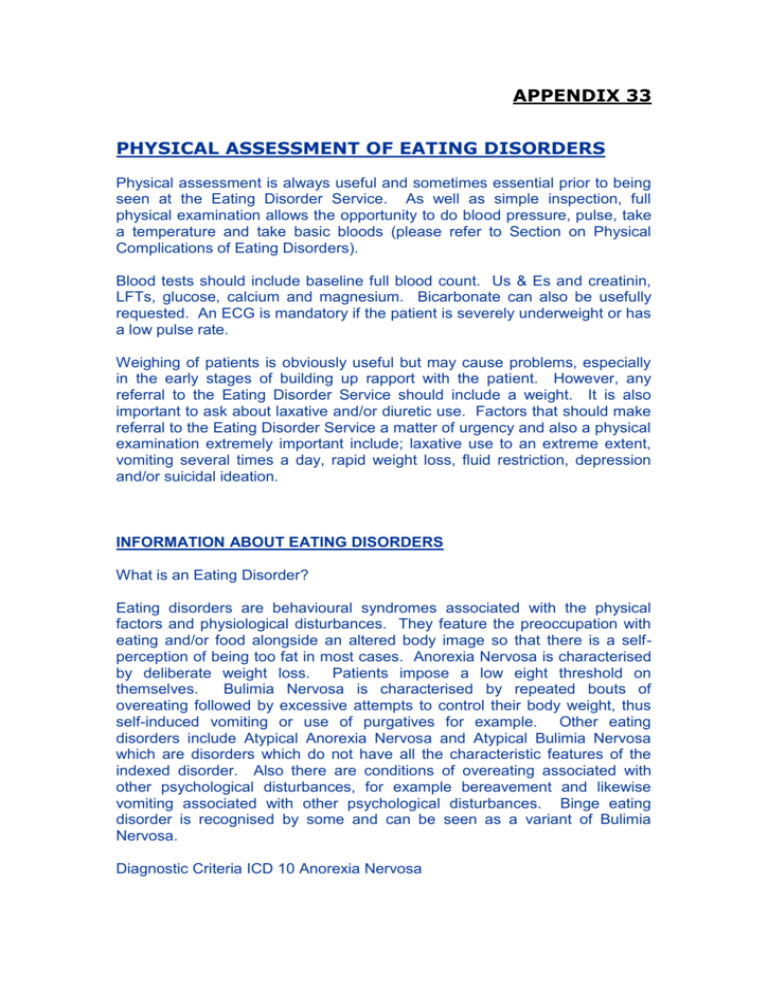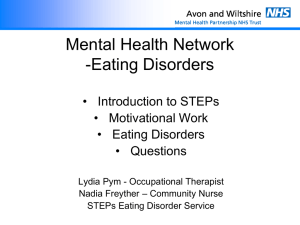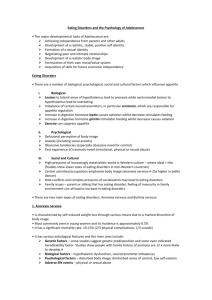Physical assessment
advertisement

APPENDIX 33 PHYSICAL ASSESSMENT OF EATING DISORDERS Physical assessment is always useful and sometimes essential prior to being seen at the Eating Disorder Service. As well as simple inspection, full physical examination allows the opportunity to do blood pressure, pulse, take a temperature and take basic bloods (please refer to Section on Physical Complications of Eating Disorders). Blood tests should include baseline full blood count. Us & Es and creatinin, LFTs, glucose, calcium and magnesium. Bicarbonate can also be usefully requested. An ECG is mandatory if the patient is severely underweight or has a low pulse rate. Weighing of patients is obviously useful but may cause problems, especially in the early stages of building up rapport with the patient. However, any referral to the Eating Disorder Service should include a weight. It is also important to ask about laxative and/or diuretic use. Factors that should make referral to the Eating Disorder Service a matter of urgency and also a physical examination extremely important include; laxative use to an extreme extent, vomiting several times a day, rapid weight loss, fluid restriction, depression and/or suicidal ideation. INFORMATION ABOUT EATING DISORDERS What is an Eating Disorder? Eating disorders are behavioural syndromes associated with the physical factors and physiological disturbances. They feature the preoccupation with eating and/or food alongside an altered body image so that there is a selfperception of being too fat in most cases. Anorexia Nervosa is characterised by deliberate weight loss. Patients impose a low eight threshold on themselves. Bulimia Nervosa is characterised by repeated bouts of overeating followed by excessive attempts to control their body weight, thus self-induced vomiting or use of purgatives for example. Other eating disorders include Atypical Anorexia Nervosa and Atypical Bulimia Nervosa which are disorders which do not have all the characteristic features of the indexed disorder. Also there are conditions of overeating associated with other psychological disturbances, for example bereavement and likewise vomiting associated with other psychological disturbances. Binge eating disorder is recognised by some and can be seen as a variant of Bulimia Nervosa. Diagnostic Criteria ICD 10 Anorexia Nervosa a) There is weight loss, or in children lack of weight gain, leading to a body weight of at least 15% below the expected, or BMI17.5 or less. b) Weight loss self induced by avoidance of fattening foods. c) Self perception of being too fat, a dread of fatness, a self-imposed low weight. d) An endocrine disorder manifesting in women as amenorrhoea and in men as a loss of sexual interest. Diagnostic Criteria ICD 10 Bulimia Nervosa a) Recurrent episodes of overeating at least twice a week for a period of 3 months. b) Patients attempts to counteract the fattening effects of food by one or more of the following: i) ii) iii) iv) Self-induced vomiting Self-induced purging Alternating periods of starvation Use of drugs such as appetite suppressants, thyroid preparations or diuretics. Neglecting insulin treatment in a diabetic. c) Self perception of being too fat with a dread of fatness. EFFECTS OF STARVATION Anorexia Nervosa is a condition of self-induced starvation. Starvation affects many systems. Most changes are completely reversible as weight is regained and these include psychological symptoms. 1. Metabolic and Endocrine Effects: these are changes that are adaptive and are about trying to conserve body mass. Growth rate is slowed and puberty will be delayed. Physical activity is often initially reduced but there can be symptoms of hyperactivity in some. Cortisol and insulin secretion are both altered. Muscle starts being broken down to use as an energy source. As starvation proceeds losses of electrolytes such as calcium, potassium, sodium and magnesium occur. There will be marked loss of calcium from bones. Patients with Anorexia Nervosa are as much at risk of Osteoporosis as women in their 70’s and 80’s. Overall muscle, liver and gut all shrink very rapidly. Shrinkage in the gastrointestinal tract means feelings of fullness even after only little amounts of food are eaten. Later on kidneys and heart may also lose mass. Women, if post puberty, will become amenorrhoeaic and Anorexia Nervosa and Bulimia Nervosa are diagnosis that should be considered in cases of infertility. 2 Cardiovascular Changes: with weight loss a patient can become bradycardic and arrhythmias are sometimes seen particularly where there is low potassium. Cardiac arrest occasionally occurs. Blood pressure is low in Anorexia Nervosa and there may be postural hypotension. 3 Biochemistry: dehydration can occur with vomiting, laxative misuse or fluid restriction. 4 Low Sodium, Low Potassium and sometimes low levels of other elements such as calcium, magnesium are sometimes seen. Phosphate supplements may be needed, especially when patients are being re-fed. Repeated vomiting can cause an alkalosis. 5 Vomiting and Laxative Abuse: can disturb fluid balance which can lead to an accumulation of fluid, especially in the ankles. Hypoglycaemia and abnormal glucose tolerance are sometimes seen and there can be a variety of protein and vitamin deficiencies. All these disturbances can cause weakness and lack of energy. 6 Skeletal Changes: in Anorexia nervosa, osteoporosis is frequently seen. Due to lack of calcium and vitamin D particularly. Low oestrogen levels also play part. There can be growth retardation before full stature is reached. A Milder form of bone thinning is osteopaenia. Fractures can occur as a result. 7 Body Temperature: cold intolerance is seen with Anorexia Nervosa and very low body temperature or hypothermia can occur. Raynaud’s Phenomenon is also often seen. 8 Gastrointestinal Tract: damage to the teeth can result from repeated vomiting as well as inflammation of the throat and swelling of the parotid glands. Oesophageal tears are sometimes seen and atomic bowel can occur from excessive laxative abuse. Dependence on laxatives is then seen. 9 Haematological: anaemia can occur adding to weakness and tiredness. White cell counts are also impaired and immune deficiency state can result. Occasionally low platelet concentrations can lead to clotting problems. 10 Dermatological: skin may become dry or discoloured. Excess hair growth on the face, arms and down the neck is often seen in Anorexia Nervosa. Lanugo hair. 11 Renal, Liver and Pancreatic Function: in advanced Anorexia Nervosa these three systems can all be impaired. 12 Neuro-Psychiatric: cognition is slowed, concentration is impaired and thinking becomes very restricted and focused in established Anorexia Nervosa. States of depression and anxiety can result in both Bulimia and Anorexia Nervosa. 13 Muscle Changes: in advanced stages of Anorexia Nervosa there can be severe muscle weakness.









